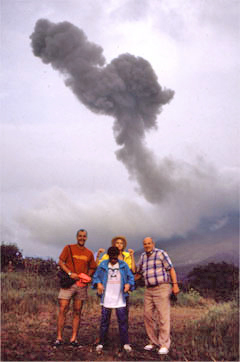Now is the prime time to travel into Mexico’s Copper Canyon and as travelers make their way into the canyon, so does our book, The California Native Copper Canyon Companion.

The book is a great tool to take along on any trip to Copper Canyon. It is filled with useful information, including lists of birds and plants, a table of mileage and distances, and a sightseer’s log of the Chihuahua al Pacifico Railroad. Written by members of our California Native staff, the Companion is a compendium of the many of the stories and photographs of Copper Canyon which have appeared in our newsletter over the past decades.
In its pages, you will meet the Tarahumara Indians—the cave-dwelling indigenous people who have lived in this area for centuries, and our California Native guides share with you their personal memories and affection for these proud people who refused to be conquered by both the Spaniards and the modern world.
The stories will take you back in time and introduce you to the 17th-century conquistadors and priests who radically changed the history of the Americas, and the 19th-century Americans who left their mark—Alexander Shepherd, who developed the silver mines into some of the richest in the world, and Albert Kimsey Owen, who established a utopian colony at Topolobampo Bay and, along with Arthur Stilwell, conceived the fantastic rail line which traverses the area. There are also stories about heroes and villains—Father Miguel Hidalgo, the “Father of Mexico,” Emperor Maximilian, who was installed by France to rule the country, and Pancho Villa, hero or villain of the Revolution.
Considering a trip? This book will give you an in-depth look into this unique region of Mexico’s Sierra Madres. Already been there? The stories and pictures will bring back wonderful memories and help you to share them with your friends. I know you’ll enjoy reading The Copper Canyon Companion as much as we have enjoyed putting it together.

 After a summer spent in the frigid waters of the Chukchi and Bering Seas, feasting on immense quantities of small crustaceans, the California Gray Whales begin their annual migration south to Mexico’s Baja California. Swimming 5000 miles along the North American coast, they arrive in the warm, protected bays to breed, give birth, and rear their infants.
After a summer spent in the frigid waters of the Chukchi and Bering Seas, feasting on immense quantities of small crustaceans, the California Gray Whales begin their annual migration south to Mexico’s Baja California. Swimming 5000 miles along the North American coast, they arrive in the warm, protected bays to breed, give birth, and rear their infants.
 Easily accessible from La Paz and Loreto, Lopez Mateos and San Carlos are two coastal towns where pangas, small motor boats, depart for whale watching. Skimming along the water with frigate birds soaring overhead and whales breaching in every direction is an unforgettable experience.
Easily accessible from La Paz and Loreto, Lopez Mateos and San Carlos are two coastal towns where pangas, small motor boats, depart for whale watching. Skimming along the water with frigate birds soaring overhead and whales breaching in every direction is an unforgettable experience. Hanging upside-down from the branches of trees in Costa Rica’s lush rain forests, sleep the two and three-toed sloths. The Spanish word for sloth is perezoso, meaning “lazy”, and sloths, who sleep around eighteen hours a day, live up to their reputation.
Hanging upside-down from the branches of trees in Costa Rica’s lush rain forests, sleep the two and three-toed sloths. The Spanish word for sloth is perezoso, meaning “lazy”, and sloths, who sleep around eighteen hours a day, live up to their reputation. Basilisks, aka “Jesus Christ lizards” refer to the legendary monsters whose breath and glances were fatal to those unfortunate enough to encounter them. Basilisks are quite large, as lizards go, up to three feet long, and the males have large crests on their heads, backs, and tails. This, and the fact that they run on two legs, makes them look like little dinosaurs.
Basilisks, aka “Jesus Christ lizards” refer to the legendary monsters whose breath and glances were fatal to those unfortunate enough to encounter them. Basilisks are quite large, as lizards go, up to three feet long, and the males have large crests on their heads, backs, and tails. This, and the fact that they run on two legs, makes them look like little dinosaurs.









